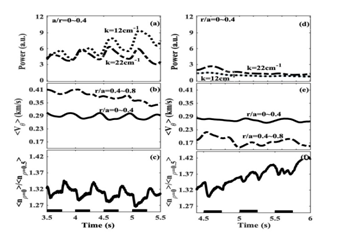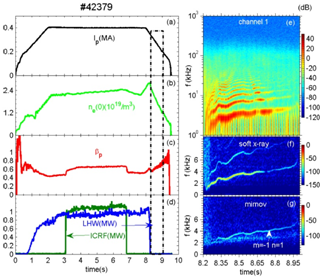
count: [2020-05-15] [Close]
Controlling fusion reaction rate in tokamak is a frontier science in fusion research. At present, the main fusion reaction rate control scheme is to adjust the plasma density in tokamak core by fueling core area, such as pellet injection and supersonic molecular beam injection, while the main challenge is that the energy confinement time is uncertain during fueling process due to the nonlinear physical feature of the burning plasma.
Through EAST experimental research utilizing CO2 laser collective scattering diagnostics, ASIPP scientists concluded with a new idea that the average value of fusion reaction rate can be controlled by modulating the frequency and intensity of the core peaked density in the tokamak.
In the 2018 EAST steady-state discharge experiments with neutral beam power injection, it’s found that the modulated electron cyclotron heating pulse can regulate the turbulence intensity in the core region, which leads to the modulation of core turbulence intensity and the regulation of plasma poloidal rotation velocity in the core, thus realizes the density peaking factor modulation in the corresponding region.
“Based on our findings,” said Prof. LI Yadong, the CO2 diagnosis team leader, “It may be a feasible method to adjust the fusion reaction rate through modulating the frequency and intensity of the core peaked density.”
By analyzing diagnostic data, they also discovered the coupling phenomenon between electronic mode turbulence and the internal kink mode under the condition with low collision rate in EAST. As indicated in their articles, micro-turbulence can couple with low-n MHD in low collision rate and high-parameter plasma, resulting in free energy exchange, which may cause low-n MHD to grow naturally. Turbulent transport across the lines of magnetic force may influence the stability of low-n MHD or even lead to crash. EAST scientists came to the conclusion that fusion researchers must take the plasma density gradient into consider in the operating regime qmin <3 with allowed high-parameter plasma because the most effective driving source for micro-turbulence is plasma density gradient.
The topics above are critical to the problem of burning plasma controlling that must be answered before practical fusion power can be developed. “There is now high readiness for our team to carry out deeper investigate on the electron thermal transport and the multi-scale physics involving electronic mode turbulence,” said Prof. LI Yadong.
The CO2 laser collective scattering diagnostics system on EAST tokamak, independently developed by ASIPP, conducts simultaneous monitoring of the electronic mode turbulence at wave number k=12cm-1 and k=22cm-1 in the core and outer regions of EAST tokamak. The research group has also conducted research on many related topics, including the interaction between electronic mode turbulence and Alfvén eigenmode, the influences of turbulence in radial and poloidal on energy confinement, dynamic evolution of electronic mode turbulence in the confinement mode conversion, the characteristic of microturbulence, etc. Since 2012, more than ten journal papers have been published based on the results of this diagnosis. (Reported and imaged by WU Guojiang)
Relevant article links:
https://doi.org/10.1088/1741-4326/ab796c
https://doi.org/10.1088/1741-4326/aa8a91
https://doi.org/10.1088/1361-6587/ab0937
https://doi.org/10.1063/1.5029516
https://doi.org /10.1088/1741-4326/ab742e
https://doi.org /10.1088/1361-6587/aa9f96
https://doi.org/10.1063/1.5049209
https://doi.org/10.1063/1.4907778
http://dx.doi.org/10.1088/0031-8949/90/8/085604
http://dx.doi.org/10.1088/0031-8949/90/2/025603
https://doi.org/10.1007/s10894-015-9861-3
https://doi.org/ 10.1007/s10894-015-9949-9

CO2 laser collective scattering diagnostics

Core density peaking factor modulation experiment

Nonlinear coupling between microturbulence and internal kink mode